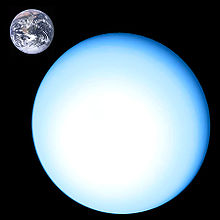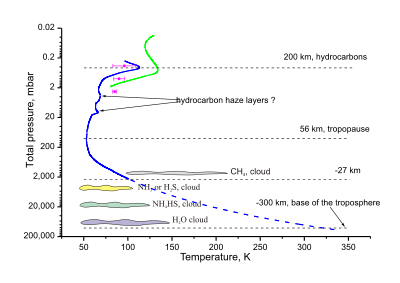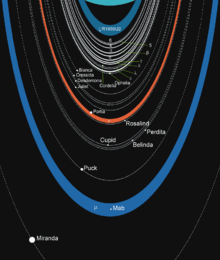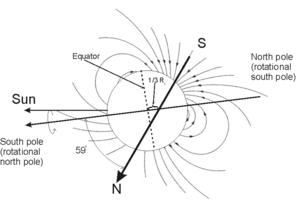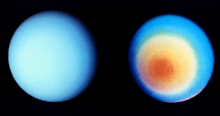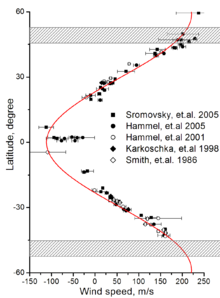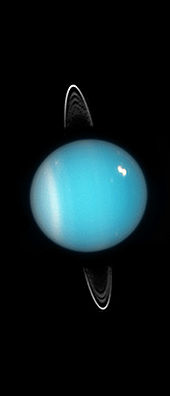- Uranus
-
This article is about the planet. For other uses, see Uranus (disambiguation).
Uranus 
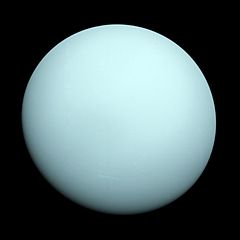 Uranus presented a nearly featureless disk to Voyager 2Discovery
Uranus presented a nearly featureless disk to Voyager 2DiscoveryDiscovered by William Herschel Discovery date March 13, 1781 DesignationsPronunciation  i/ˈjʊərənəs/ or
i/ˈjʊərənəs/ or  i/jʊˈreɪnəs/[1][2]
i/jʊˈreɪnəs/[1][2]Adjective Uranian Epoch J2000 Aphelion 3,004,419,704 km
20.083 305 26 AUPerihelion 2,748,938,461 km
18.375 518 63 AUSemi-major axis 2,876,679,082 km
19.229 411 95 AUEccentricity 0.044 405 586 Orbital period 30,799.095 days
84.323 326 yr
42,718 Uranus solar days[4]Synodic period 369.66 days[5] Average orbital speed 6.81 km/s[5] Mean anomaly 142.955 717° Inclination 0.772 556° to Ecliptic
6.48° to Sun's equator
1.02° to Invariable plane[6]Longitude of ascending node 73.989 821° Argument of perihelion 96.541 318° Satellites 27 Physical characteristicsEquatorial radius 25,559 ± 4 km
4.007 Earths[7][nb 2]Polar radius 24,973 ± 20 km
3.929 Earths[7][nb 2]Flattening 0.022 9 ± 0.000 8[nb 3] Circumference 156,909.98 km[citation needed] Surface area 8.115 6×109 km2[8][nb 2]
15.91 EarthsVolume 6.833×1013 km3[5][nb 2]
63.086 EarthsMass (8.6810 ± 0.0013)×1025 kg
14.536 Earths[9]
GM=5 793 939 ± 13 km3/s2Mean density 1.27 g/cm3[5][nb 2] Equatorial surface gravity 8.69 m/s2[5][nb 2]
0.886 gEscape velocity 21.3 km/s[5][nb 2] Sidereal rotation
period−0.718 33 day
17 h 14 min 24 s[7]Equatorial rotation velocity 2.59 km/s
9,320 km/hAxial tilt 97.77°[7] North pole right ascension 17 h 9 min 15 s
257.311°[7]North pole declination −15.175°[7] Albedo 0.300 (Bond)
0.51 (geom.)[5]Surface temp.
1 bar level[11]
0.1 bar
(tropopause)[12]min mean max 76 K 49 K 53 K 57 K Apparent magnitude 5.9[10] to 5.32[5] Angular diameter 3.3"–4.1"[5] Scale height 27.7 km[5] Composition (Below 1.3 bar) 83 ± 3% hydrogen (H2) 15 ± 3% helium 2.3% methane 0.009%
(0.007–0.015%)hydrogen deuteride (HD)[15] Ices: ammonia water ammonium hydrosulfide (NH4SH) methane (CH4) Uranus is the seventh planet from the Sun. It has the third-largest planetary radius and fourth-largest planetary mass in the Solar System. It is named after the ancient Greek deity of the sky Uranus (Ancient Greek: Οὐρανός), the father of Cronus (Saturn) and grandfather of Zeus (Jupiter). Though it is visible to the naked eye like the five classical planets, it was never recognized as a planet by ancient observers because of its dimness and slow orbit.[16] Sir William Herschel announced its discovery on March 13, 1781, expanding the known boundaries of the Solar System for the first time in modern history. Uranus was also the first planet discovered with a telescope.
Uranus is similar in composition to Neptune, and both are of different chemical composition than the larger gas giants, Jupiter and Saturn. As such, astronomers sometimes place them in a separate category called "ice giants". Uranus's atmosphere, while similar to Jupiter and Saturn's in its primary composition of hydrogen and helium, contains more "ices" such as water, ammonia and methane, along with traces of hydrocarbons.[12] It is the coldest planetary atmosphere in the Solar System, with a minimum temperature of 49 K (−224 °C). It has a complex, layered cloud structure, with water thought to make up the lowest clouds, and methane thought to make up the uppermost layer of clouds.[12] In contrast, the interior of Uranus is mainly composed of ices and rock.[11]
Like the other giant planets, Uranus has a ring system, a magnetosphere, and numerous moons. The Uranian system has a unique configuration among the planets because its axis of rotation is tilted sideways, nearly into the plane of its revolution about the Sun. As such, its north and south poles lie where most other planets have their equators.[17] Seen from Earth, Uranus's rings can sometimes appear to circle the planet like an archery target and its moons revolve around it like the hands of a clock; in 2007 and 2008 the rings appeared edge-on. In 1986, images from Voyager 2 showed Uranus as a virtually featureless planet in visible light without the cloud bands or storms associated with the other giants.[17] Terrestrial observers have seen signs of seasonal change and increased weather activity in recent years as Uranus approached its equinox. The wind speeds on Uranus can reach 250 meters per second (900 km/h, 560 mph).[18]
Contents
History
Discovery
Uranus had been observed on many occasions before its discovery as a planet, but it was generally mistaken for a star. The earliest recorded sighting was in 1690 when John Flamsteed observed the planet at least six times, cataloging it as 34 Tauri. The French astronomer Pierre Lemonnier observed Uranus at least twelve times between 1750 and 1769,[19] including on four consecutive nights.
Sir William Herschel observed the planet on March 13, 1781 while in the garden of his house at 19 New King Street in the town of Bath, Somerset, England (now the Herschel Museum of Astronomy),[20] but initially reported it (on April 26, 1781) as a "comet".[21] Herschel "engaged in a series of observations on the parallax of the fixed stars",[22] using a telescope of his own design.
He recorded in his journal "In the quartile near ζ Tauri … either [a] Nebulous star or perhaps a comet".[23] On March 17, he noted, "I looked for the Comet or Nebulous Star and found that it is a Comet, for it has changed its place".[24] When he presented his discovery to the Royal Society, he continued to assert that he had found a comet while also implicitly comparing it to a planet:[25]
“ The power I had on when I first saw the comet was 227. From experience I know that the diameters of the fixed stars are not proportionally magnified with higher powers, as planets are; therefore I now put the powers at 460 and 932, and found that the diameter of the comet increased in proportion to the power, as it ought to be, on the supposition of its not being a fixed star, while the diameters of the stars to which I compared it were not increased in the same ratio. Moreover, the comet being magnified much beyond what its light would admit of, appeared hazy and ill-defined with these great powers, while the stars preserved that lustre and distinctness which from many thousand observations I knew they would retain. The sequel has shown that my surmises were well-founded, this proving to be the Comet we have lately observed. ”  Replica of the telescope used by Herschel to discover Uranus (William Herschel Museum, Bath)
Replica of the telescope used by Herschel to discover Uranus (William Herschel Museum, Bath)
Herschel notified the Astronomer Royal, Nevil Maskelyne, of his discovery and received this flummoxed reply from him on April 23: "I don't know what to call it. It is as likely to be a regular planet moving in an orbit nearly circular to the sun as a Comet moving in a very eccentric ellipsis. I have not yet seen any coma or tail to it".[26]
While Herschel continued to cautiously describe his new object as a comet, other astronomers had already begun to suspect otherwise. Russian astronomer Anders Johan Lexell was the first to compute the orbit of the new object[27] and its nearly circular orbit led him to a conclusion that it was a planet rather than a comet. Berlin astronomer Johann Elert Bode described Herschel's discovery as "a moving star that can be deemed a hitherto unknown planet-like object circulating beyond the orbit of Saturn".[28] Bode concluded that its near-circular orbit was more like a planet than a comet.[29]
The object was soon universally accepted as a new planet. By 1783, Herschel himself acknowledged this fact to Royal Society president Joseph Banks: "By the observation of the most eminent Astronomers in Europe it appears that the new star, which I had the honour of pointing out to them in March 1781, is a Primary Planet of our Solar System."[30] In recognition of his achievement, King George III gave Herschel an annual stipend of £200 on the condition that he move to Windsor so that the Royal Family could have a chance to look through his telescopes.[31]
Naming
Maskelyne asked Herschel to "do the astronomical world the faver [sic] to give a name to your planet, which is entirely your own, [and] which we are so much obliged to you for the discovery of."[32] In response to Maskelyne's request, Herschel decided to name the object Georgium Sidus (George's Star), or the "Georgian Planet" in honour of his new patron, King George III.[33] He explained this decision in a letter to Joseph Banks:[30]
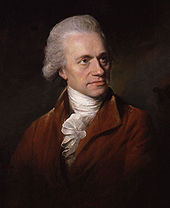 William Herschel, discoverer of Uranus
William Herschel, discoverer of Uranus
“ In the fabulous ages of ancient times the appellations of Mercury, Venus, Mars, Jupiter and Saturn were given to the Planets, as being the names of their principal heroes and divinities. In the present more philosophical era it would hardly be allowable to have recourse to the same method and call it Juno, Pallas, Apollo or Minerva, for a name to our new heavenly body. The first consideration of any particular event, or remarkable incident, seems to be its chronology: if in any future age it should be asked, when this last-found Planet was discovered? It would be a very satisfactory answer to say, 'In the reign of King George the Third' . ” Herschel's proposed name was not popular outside of Britain, and alternatives were soon proposed. Astronomer Jérôme Lalande proposed the planet be named Herschel in honour of its discoverer.[34] Swedish astronomer Erik Prosperin proposed the name Neptune which was supported by other astronomers who liked the idea to commemorate the victories of the British Royal Naval fleet in the course of the American Revolutionary War by calling the new planet even Neptune George III or Neptune Great Britain.[27] Bode opted for Uranus, the Latinized version of the Greek god of the sky, Ouranos. Bode argued that just as Saturn was the father of Jupiter, the new planet should be named after the father of Saturn.[31][35][36] In 1789, Bode's Royal Academy colleague Martin Klaproth named his newly discovered element "uranium" in support of Bode's choice.[37] Ultimately, Bode's suggestion became the most widely used, and became universal in 1850 when HM Nautical Almanac Office, the final holdout, switched from using Georgium Sidus to Uranus.[35]
Nomenclature
The pronunciation of the name Uranus preferred among astronomers is /ˈjʊərənəs/,[2][38] with stress on the first syllable as in Latin Ūranus; in contrast to the colloquial /jʊˈreɪnəs/,[39] with stress on the second syllable and a long a, though both are considered acceptable.[nb 5]
Uranus is the only planet whose name is derived from a figure from Greek mythology rather than Roman mythology: the Greek "Οὐρανός" arrived in English by way of the Latin "Ūranus".[1] The adjective of Uranus is "Uranian".[41] It has two astronomical symbols. The first to be proposed, ♅,[nb 6] was suggested by Lalande in 1784. In a letter to Herschel, Lalande described it as "un globe surmonté par la première lettre de votre nom" ("a globe surmounted by the first letter of your surname").[34] A later proposal, ⛢,[nb 7] is a hybrid of the symbols for Mars and the Sun because Uranus was the Sky in Greek mythology, which was thought to be dominated by the combined powers of the Sun and Mars.[42] In the Chinese, Japanese, Korean, and Vietnamese languages, the planet's name is literally translated as the sky king star (天王星).[43][44]
Orbit and rotation
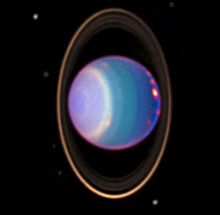 A 1998 false-colour near-infrared image of Uranus showing cloud bands, rings, and moons obtained by the Hubble Space Telescope's NICMOS camera.
A 1998 false-colour near-infrared image of Uranus showing cloud bands, rings, and moons obtained by the Hubble Space Telescope's NICMOS camera.
Uranus revolves around the Sun once every 84 Earth years. Its average distance from the Sun is roughly 3 billion km (about 20 AU). The intensity of sunlight on Uranus is about 1/400 that on Earth.[45] Its orbital elements were first calculated in 1783 by Pierre-Simon Laplace.[46] With time, discrepancies began to appear between the predicted and observed orbits, and in 1841, John Couch Adams first proposed that the differences might be due to the gravitational tug of an unseen planet. In 1845, Urbain Le Verrier began his own independent research into Uranus's orbit. On September 23, 1846, Johann Gottfried Galle located a new planet, later named Neptune, at nearly the position predicted by Le Verrier.[47]
The rotational period of the interior of Uranus is 17 hours, 14 minutes. As on all giant planets, its upper atmosphere experiences very strong winds in the direction of rotation. At some latitudes, such as about two-thirds of the way from the equator to the south pole, visible features of the atmosphere move much faster, making a full rotation in as little as 14 hours.[48]
Axial tilt
Uranus has an axial tilt of 97.77 degrees, so its axis of rotation is approximately parallel with the plane of the Solar System. This gives it seasonal changes completely unlike those of the other major planets. Other planets can be visualized to rotate like tilted spinning tops on the plane of the Solar System, while Uranus rotates more like a tilted rolling ball. Near the time of Uranian solstices, one pole faces the Sun continuously while the other pole faces away. Only a narrow strip around the equator experiences a rapid day-night cycle, but with the Sun very low over the horizon as in the Earth's polar regions. At the other side of Uranus's orbit the orientation of the poles towards the Sun is reversed. Each pole gets around 42 years of continuous sunlight, followed by 42 years of darkness.[49] Near the time of the equinoxes, the Sun faces the equator of Uranus giving a period of day-night cycles similar to those seen on most of the other planets. Uranus reached its most recent equinox on December 7, 2007.[50][51]
Northern hemisphere Year Southern hemisphere Winter solstice 1902, 1986 Summer solstice Vernal equinox 1923, 2007 Autumnal equinox Summer solstice 1944, 2028 Winter solstice Autumnal equinox 1965, 2049 Vernal equinox One result of this axis orientation is that, on average during the year, the polar regions of Uranus receive a greater energy input from the Sun than its equatorial regions. Nevertheless, Uranus is hotter at its equator than at its poles. The underlying mechanism which causes this is unknown. The reason for Uranus's unusual axial tilt is also not known with certainty, but the usual speculation is that during the formation of the Solar System, an Earth sized protoplanet collided with Uranus, causing the skewed orientation.[52] Uranus's south pole was pointed almost directly at the Sun at the time of Voyager 2's flyby in 1986. The labeling of this pole as "south" uses the definition currently endorsed by the International Astronomical Union, namely that the north pole of a planet or satellite shall be the pole which points above the invariable plane of the Solar System, regardless of the direction the planet is spinning.[53][54] A different convention is sometimes used, in which a body's north and south poles are defined according to the right-hand rule in relation to the direction of rotation.[55] In terms of this latter coordinate system it was Uranus's north pole which was in sunlight in 1986.
Visibility
From 1995 to 2006, Uranus's apparent magnitude fluctuated between +5.6 and +5.9, placing it just within the limit of naked eye visibility at +6.5.[10] Its angular diameter is between 3.4 and 3.7 arcseconds, compared with 16 to 20 arcseconds for Saturn and 32 to 45 arcseconds for Jupiter.[10] At opposition, Uranus is visible to the naked eye in dark skies, and becomes an easy target even in urban conditions with binoculars.[8] In larger amateur telescopes with an objective diameter of between 15 and 23 cm, the planet appears as a pale cyan disk with distinct limb darkening. With a large telescope of 25 cm or wider, cloud patterns, as well as some of the larger satellites, such as Titania and Oberon, may be visible.[56]
Internal structure
Uranus's mass is roughly 14.5 times that of the Earth, making it the least massive of the giant planets. Its diameter is slightly larger than Neptune's at roughly four times Earth's. A resulting density of 1.27 g/cm3 makes Uranus the second least dense planet, after Saturn.[7][9] This value indicates that it is made primarily of various ices, such as water, ammonia, and methane.[11] The total mass of ice in Uranus's interior is not precisely known, as different figures emerge depending on the model chosen; it must be between 9.3 and 13.5 Earth masses.[11][57] Hydrogen and helium constitute only a small part of the total, with between 0.5 and 1.5 Earth masses.[11] The remainder of the non-ice mass (0.5 to 3.7 Earth masses) is accounted for by rocky material.[11]
The standard model of Uranus's structure is that it consists of three layers: a rocky (silicate/iron-nickel) core in the center, an icy mantle in the middle and an outer gaseous hydrogen/helium envelope.[11][58] The core is relatively small, with a mass of only 0.55 Earth masses and a radius less than 20% of Uranus's; the mantle comprises the bulk of the planet, with around 13.4 Earth masses, while the upper atmosphere is relatively insubstantial, weighing about 0.5 Earth masses and extending for the last 20% of Uranus's radius.[11][58] Uranus's core density is around 9 g/cm3, with a pressure in the center of 8 million bars (800 GPa) and a temperature of about 5000 K.[57][58] The ice mantle is not in fact composed of ice in the conventional sense, but of a hot and dense fluid consisting of water, ammonia and other volatiles.[11][58] This fluid, which has a high electrical conductivity, is sometimes called a water–ammonia ocean.[59] The bulk compositions of Uranus and Neptune are very different from those of Jupiter and Saturn, with ice dominating over gases, hence justifying their separate classification as ice giants. There may be a layer of ionic water where the water molecules break down into a soup of hydrogen and oxygen ions, and deeper down superionic water in which the oxygen crystallises but the hydrogen ions move freely within the oxygen lattice.[60]
While the model considered above is reasonably standard, it is not unique; other models also satisfy observations. For instance, if substantial amounts of hydrogen and rocky material are mixed in the ice mantle, the total mass of ices in the interior will be lower, and, correspondingly, the total mass of rocks and hydrogen will be higher. Presently available data does not allow science to determine which model is correct.[57] The fluid interior structure of Uranus means that it has no solid surface. The gaseous atmosphere gradually transitions into the internal liquid layers.[11] For the sake of convenience, a revolving oblate spheroid set at the point at which atmospheric pressure equals 1 bar (100 kPa) is conditionally designated as a "surface". It has equatorial and polar radii of 25 559 ± 4 and 24 973 ± 20 km, respectively.[7] This surface will be used throughout this article as a zero point for altitudes.
Internal heat
Uranus's internal heat appears markedly lower than that of the other giant planets; in astronomical terms, it has a low thermal flux.[18][61] Why Uranus's internal temperature is so low is still not understood. Neptune, which is Uranus's near twin in size and composition, radiates 2.61 times as much energy into space as it receives from the Sun.[18] Uranus, by contrast, radiates hardly any excess heat at all. The total power radiated by Uranus in the far infrared (i.e. heat) part of the spectrum is 1.06 ± 0.08 times the solar energy absorbed in its atmosphere.[12][62] In fact, Uranus's heat flux is only 0.042 ± 0.047 W/m2, which is lower than the internal heat flux of Earth of about 0.075 W/m2.[62] The lowest temperature recorded in Uranus's tropopause is 49 K (–224 °C), making Uranus the coldest planet in the Solar System.[12][62]
One of the hypotheses for this discrepancy suggests that when Uranus was hit by a supermassive impactor, which caused it to expel most of its primordial heat, it was left with a depleted core temperature.[63] Another hypothesis is that some form of barrier exists in Uranus's upper layers which prevents the core's heat from reaching the surface.[11] For example, convection may take place in a set of compositionally different layers, which may inhibit the upward heat transport.[12][62]
Atmosphere
Main article: Atmosphere of UranusAlthough there is no well-defined solid surface within Uranus's interior, the outermost part of Uranus's gaseous envelope that is accessible to remote sensing is called its atmosphere.[12] Remote sensing capability extends down to roughly 300 km below the 1 bar (100 kPa) level, with a corresponding pressure around 100 bar (10 MPa) and temperature of 320 K.[64] The tenuous corona of the atmosphere extends remarkably over two planetary radii from the nominal surface at 1 bar pressure.[65] The Uranian atmosphere can be divided into three layers: the troposphere, between altitudes of −300 and 50 km and pressures from 100 to 0.1 bar; (10 MPa to 10 kPa), the stratosphere, spanning altitudes between 50 and 4000 km and pressures of between 0.1 and 10–10 bar (10 kPa to 10 µPa), and the thermosphere/corona extending from 4,000 km to as high as 50,000 km from the surface.[12] There is no mesosphere.
Composition
The composition of the Uranian atmosphere is different from the rest of the planet, consisting as it does mainly of molecular hydrogen and helium.[12] The helium molar fraction, i.e. the number of helium atoms per molecule of gas, is 0.15 ± 0.03[14] in the upper troposphere, which corresponds to a mass fraction 0.26 ± 0.05.[12][62] This value is very close to the protosolar helium mass fraction of 0.275 ± 0.01,[66] indicating that helium has not settled in the center of the planet as it has in the gas giants.[12] The third most abundant constituent of the Uranian atmosphere is methane (CH4).[12] Methane possesses prominent absorption bands in the visible and near-infrared (IR) making Uranus aquamarine or cyan in color.[12] Methane molecules account for 2.3% of the atmosphere by molar fraction below the methane cloud deck at the pressure level of 1.3 bar (130 kPa); this represents about 20 to 30 times the carbon abundance found in the Sun.[12][13][67] The mixing ratio[nb 8] is much lower in the upper atmosphere owing to its extremely low temperature, which lowers the saturation level and causes excess methane to freeze out.[68] The abundances of less volatile compounds such as ammonia, water and hydrogen sulfide in the deep atmosphere are poorly known. They are probably also higher than solar values.[12][69] Along with methane, trace amounts of various hydrocarbons are found in the stratosphere of Uranus, which are thought to be produced from methane by photolysis induced by the solar ultraviolet (UV) radiation.[70] They include ethane (C2H6), acetylene (C2H2), methylacetylene (CH3C2H), diacetylene (C2HC2H).[68][71][72] Spectroscopy has also uncovered traces of water vapor, carbon monoxide and carbon dioxide in the upper atmosphere, which can only originate from an external source such as infalling dust and comets.[71][72][73]
Troposphere
The troposphere is the lowest and densest part of the atmosphere and is characterized by a decrease in temperature with altitude.[12] The temperature falls from about 320 K at the base of the nominal troposphere at −300 km to 53 K at 50 km.[64][67] The temperatures in the coldest upper region of the troposphere (the tropopause) actually vary in the range between 49 and 57 K depending on planetary latitude.[12][61] The tropopause region is responsible for the vast majority of the planet’s thermal far infrared emissions, thus determining its effective temperature of 59.1 ± 0.3 K.[61][62]
The troposphere is believed to possess a highly complex cloud structure; water clouds are hypothesised to lie in the pressure range of 50 to 100 bar (5 to 10 MPa), ammonium hydrosulfide clouds in the range of 20 to 40 bar (2 to 4 MPa), ammonia or hydrogen sulfide clouds at between 3 and 10 bar (0.3 to 1 MPa) and finally directly detected thin methane clouds at 1 to 2 bar (0.1 to 0.2 MPa).[12][13][64][74] The troposphere is a very dynamic part of the atmosphere, exhibiting strong winds, bright clouds and seasonal changes, which will be discussed below.[18]
Upper atmosphere
The middle layer of the Uranian atmosphere is the stratosphere, where temperature generally increases with altitude from 53 K in the tropopause to between 800 and 850 K at the base of the thermosphere.[65] The heating of the stratosphere is caused by absorption of solar UV and IR radiation by methane and other hydrocarbons,[75] which form in this part of the atmosphere as a result of methane photolysis.[70] Heat is also conducted from the hot thermosphere.[75] The hydrocarbons occupy a relatively narrow layer at altitudes of between 100 and 300 km corresponding to a pressure range of 10 to 0.1 mbar (1000 to 10 kPa) and temperatures of between 75 and 170 K.[68][71] The most abundant hydrocarbons are methane, acetylene and ethane with mixing ratios of around 10−7 relative to hydrogen. The mixing ratio of carbon monoxide is similar at these altitudes.[68][71][73] Heavier hydrocarbons and carbon dioxide have mixing ratios three orders of magnitude lower.[71] The abundance ratio of water is around 7×10−9.[72] Ethane and acetylene tend to condense in the colder lower part of stratosphere and tropopause (below 10 mBar level) forming haze layers,[70] which may be partly responsible for the bland appearance of Uranus. The concentration of hydrocarbons in the Uranian stratosphere above the haze is significantly lower than in the stratospheres of the other giant planets.[68][76]
The outermost layer of the Uranian atmosphere is the thermosphere and corona, which has a uniform temperature around 800 to 850 K.[12][76] The heat sources necessary to sustain such a high value are not understood, since neither solar far UV and extreme UV radiation nor auroral activity can provide the necessary energy. The weak cooling efficiency due to the lack of hydrocarbons in the stratosphere above 0.1 mBar pressure level may contribute too.[65][76] In addition to molecular hydrogen, the thermosphere-corona contains many free hydrogen atoms. Their small mass together with the high temperatures explain why the corona extends as far as 50 000 km or two Uranian radii from the planet.[65][76] This extended corona is a unique feature of Uranus.[76] Its effects include a drag on small particles orbiting Uranus, causing a general depletion of dust in the Uranian rings.[65] The Uranian thermosphere, together with the upper part of the stratosphere, corresponds to the ionosphere of Uranus.[67] Observations show that the ionosphere occupies altitudes from 2 000 to 10 000 km.[67] The Uranian ionosphere is denser than that of either Saturn or Neptune, which may arise from the low concentration of hydrocarbons in the stratosphere.[76][77] The ionosphere is mainly sustained by solar UV radiation and its density depends on the solar activity.[78] Auroral activity is insignificant as compared to Jupiter and Saturn.[76][79]
Planetary rings
Main article: Rings of Uranus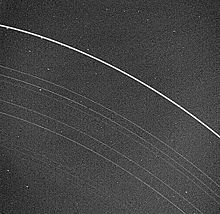 Uranus's inner rings. The bright outer ring is the ε ring; eight other rings are present.
Uranus's inner rings. The bright outer ring is the ε ring; eight other rings are present.
Uranus has a complicated planetary ring system, which was the second such system to be discovered in the Solar System after Saturn's.[80] The rings are composed of extremely dark particles, which vary in size from micrometers to a fraction of a meter.[17] Thirteen distinct rings are presently known, the brightest being the ε ring. All except two rings of Uranus are extremely narrow—they are usually a few kilometres wide. The rings are probably quite young; the dynamics considerations indicate that they did not form with Uranus. The matter in the rings may once have been part of a moon (or moons) that was shattered by high-speed impacts. From numerous pieces of debris that formed as result of those impacts only few particles survived in a limited number of stable zones corresponding to present rings.[80][81]
William Herschel described a possible ring around Uranus in 1789. This sighting is generally considered doubtful, as the rings are quite faint, and in the two following centuries none were noted by other observers. Still, Herschel made an accurate description of the epsilon ring's size, its angle relative to the Earth, its red color, and its apparent changes as Uranus traveled around the Sun.[82][83] The ring system was definitively discovered on March 10, 1977 by James L. Elliot, Edward W. Dunham, and Douglas J. Mink using the Kuiper Airborne Observatory. The discovery was serendipitous; they planned to use the occultation of the star SAO 158687 by Uranus to study the planet's atmosphere. When their observations were analyzed, they found that the star had disappeared briefly from view five times both before and after it disappeared behind the planet. They concluded that there must be a ring system around the planet.[84] Later they detected four additional rings.[84] The rings were directly imaged when Voyager 2 passed Uranus in 1986.[17] Voyager 2 also discovered two additional faint rings bringing the total number to eleven.[17]
In December 2005, the Hubble Space Telescope detected a pair of previously unknown rings. The largest is located at twice the distance from the planet of the previously known rings. These new rings are so far from the planet that they are called the "outer" ring system. Hubble also spotted two small satellites, one of which, Mab, shares its orbit with the outermost newly discovered ring. The new rings bring the total number of Uranian rings to 13.[85] In April 2006, images of the new rings with the Keck Observatory yielded the colours of the outer rings: the outermost is blue and the other red.[86][87] One hypothesis concerning the outer ring's blue colour is that it is composed of minute particles of water ice from the surface of Mab that are small enough to scatter blue light.[86][88] In contrast, the planet's inner rings appear grey.[86]
Magnetic field
Before the arrival of Voyager 2, no measurements of the Uranian magnetosphere had been taken, so its nature remained a mystery. Before 1986, astronomers had expected the magnetic field of Uranus to be in line with the solar wind, since it would then align with the planet's poles that lie in the ecliptic.[89]
Voyager's observations revealed that the magnetic field is peculiar, both because it does not originate from the planet's geometric center, and because it is tilted at 59° from the axis of rotation.[89][90] In fact the magnetic dipole is shifted from the center of the planet towards the south rotational pole by as much as one third of the planetary radius.[89] This unusual geometry results in a highly asymmetric magnetosphere, where the magnetic field strength on the surface in the southern hemisphere can be as low as 0.1 gauss (10 µT), whereas in the northern hemisphere it can be as high as 1.1 gauss (110 µT).[89] The average field at the surface is 0.23 gauss (23 µT).[89] In comparison, the magnetic field of Earth is roughly as strong at either pole, and its "magnetic equator" is roughly parallel with its geographical equator.[90] The dipole moment of Uranus is 50 times that of Earth.[89][90] Neptune has a similarly displaced and tilted magnetic field, suggesting that this may be a common feature of ice giants.[90] One hypothesis is that, unlike the magnetic fields of the terrestrial and gas giant planets, which are generated within their cores, the ice giants' magnetic fields are generated by motion at relatively shallow depths, for instance, in the water–ammonia ocean.[59][91]
Despite its curious alignment, in other respects the Uranian magnetosphere is like those of other planets: it has a bow shock located at about 23 Uranian radii ahead of it, a magnetopause at 18 Uranian radii, a fully developed magnetotail and radiation belts.[89][90][92] Overall, the structure of Uranus's magnetosphere is different from Jupiter's and more similar to Saturn's.[89][90] Uranus's magnetotail trails behind the planet into space for millions of kilometers and is twisted by the planet's sideways rotation into a long corkscrew.[89][93]
Uranus's magnetosphere contains charged particles: protons and electrons with small amount of H2+ ions.[90][92] No heavier ions have been detected. Many of these particles probably derive from the hot atmospheric corona.[92] The ion and electron energies can be as high as 4 and 1.2 megaelectronvolts, respectively.[92] The density of low energy (below 1 kiloelectronvolt) ions in the inner magnetosphere is about 2 cm−3.[94] The particle population is strongly affected by the Uranian moons that sweep through the magnetosphere leaving noticeable gaps.[92] The particle flux is high enough to cause darkening or space weathering of the moon’s surfaces on an astronomically rapid timescale of 100,000 years.[92] This may be the cause of the uniformly dark colouration of the moons and rings.[81] Uranus has relatively well developed aurorae, which are seen as bright arcs around both magnetic poles.[76] Unlike Jupiter's, Uranus's aurorae seem to be insignificant for the energy balance of the planetary thermosphere.[79]
Climate
Main article: Climate of UranusAt ultraviolet and visible wavelengths, Uranus's atmosphere is remarkably bland in comparison to the other gas giants, even to Neptune, which it otherwise closely resembles.[18] When Voyager 2 flew by Uranus in 1986, it observed a total of ten cloud features across the entire planet.[17][95] One proposed explanation for this dearth of features is that Uranus's internal heat appears markedly lower than that of the other giant planets. The lowest temperature recorded in Uranus's tropopause is 49 K, making Uranus the coldest planet in the Solar System, colder than Neptune.[12][62]
Banded structure, winds and clouds
In 1986 Voyager 2 found that the visible southern hemisphere of Uranus can be subdivided into two regions: a bright polar cap and dark equatorial bands (see figure on the right).[17] Their boundary is located at about −45 degrees of latitude. A narrow band straddling the latitudinal range from −45 to −50 degrees is the brightest large feature on the visible surface of the planet.[17][96] It is called a southern "collar". The cap and collar are thought to be a dense region of methane clouds located within the pressure range of 1.3 to 2 bar (see above).[97] Besides the large-scale banded structure, Voyager 2 observed ten small bright clouds, most lying several degrees to the north from the collar.[17] In all other respects Uranus looked like a dynamically dead planet in 1986. Unfortunately Voyager 2 arrived during the height of the planet's southern summer and could not observe the northern hemisphere. At the beginning of the 21st century, when the northern polar region came into view, the Hubble Space Telescope (HST) and Keck telescope initially observed neither a collar nor a polar cap in the northern hemisphere.[96] So Uranus appeared to be asymmetric: bright near the south pole and uniformly dark in the region north of the southern collar.[96] In 2007, when Uranus passed its equinox, the southern collar almost disappeared, while a faint northern collar emerged near 45 degrees of latitude.[98]
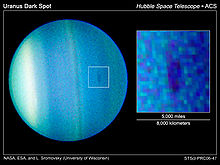 The first dark spot observed on Uranus. Image obtained by the HST ACS in 2006.
The first dark spot observed on Uranus. Image obtained by the HST ACS in 2006.
In the 1990s, the number of the observed bright cloud features grew considerably partly because new high resolution imaging techniques became available.[18] Most were found in the northern hemisphere as it started to become visible.[18] An early explanation—that bright clouds are easier to identify in the dark part of the planet, whereas in the southern hemisphere the bright collar masks them—was shown to be incorrect: the actual number of features has indeed increased considerably.[99][100] Nevertheless there are differences between the clouds of each hemisphere. The northern clouds are smaller, sharper and brighter.[100] They appear to lie at a higher altitude.[100] The lifetime of clouds spans several orders of magnitude. Some small clouds live for hours, while at least one southern cloud may have persisted since Voyager flyby.[18][95] Recent observation also discovered that cloud features on Uranus have a lot in common with those on Neptune.[18] For example, the dark spots common on Neptune had never been observed on Uranus before 2006, when the first such feature dubbed Uranus Dark Spot was imaged.[101] The speculation is that Uranus is becoming more Neptune-like during its equinoctial season.[102]
The tracking of numerous cloud features allowed determination of zonal winds blowing in the upper troposphere of Uranus.[18] At the equator winds are retrograde, which means that they blow in the reverse direction to the planetary rotation. Their speeds are from −100 to −50 m/s.[18][96] Wind speeds increase with the distance from the equator, reaching zero values near ±20° latitude, where the troposphere's temperature minimum is located.[18][61] Closer to the poles, the winds shift to a prograde direction, flowing with the planet's rotation. Windspeeds continue to increase reaching maxima at ±60° latitude before falling to zero at the poles.[18] Windspeeds at −40° latitude range from 150 to 200 m/s. Since the collar obscures all clouds below that parallel, speeds between it and the southern pole are impossible to measure.[18] In contrast, in the northern hemisphere maximum speeds as high as 240 m/s are observed near +50 degrees of latitude.[18][96][103]
Seasonal variation
For a short period from March to May 2004, a number of large clouds appeared in the Uranian atmosphere, giving it a Neptune-like appearance.[100][104] Observations included record-breaking wind speeds of 229 m/s (824 km/h) and a persistent thunderstorm referred to as "Fourth of July fireworks".[95] On August 23, 2006, researchers at the Space Science Institute (Boulder, CO) and the University of Wisconsin observed a dark spot on Uranus's surface, giving astronomers more insight into the planet's atmospheric activity.[101] Why this sudden upsurge in activity should be occurring is not fully known, but it appears that Uranus's extreme axial tilt results in extreme seasonal variations in its weather.[51][102] Determining the nature of this seasonal variation is difficult because good data on Uranus's atmosphere have existed for less than 84 years, or one full Uranian year. A number of discoveries have been made. Photometry over the course of half a Uranian year (beginning in the 1950s) has shown regular variation in the brightness in two spectral bands, with maxima occurring at the solstices and minima occurring at the equinoxes.[105] A similar periodic variation, with maxima at the solstices, has been noted in microwave measurements of the deep troposphere begun in the 1960s.[106] Stratospheric temperature measurements beginning in the 1970s also showed maximum values near the 1986 solstice.[75] The majority of this variability is believed to occur owing to changes in the viewing geometry.[99]
There are some reasons to believe that physical seasonal changes are happening in Uranus. While the planet is known to have a bright south polar region, the north pole is fairly dim, which is incompatible with the model of the seasonal change outlined above.[102] During its previous northern solstice in 1944, Uranus displayed elevated levels of brightness, which suggests that the north pole was not always so dim.[105] This information implies that the visible pole brightens some time before the solstice and darkens after the equinox.[102] Detailed analysis of the visible and microwave data revealed that the periodical changes of brightness are not completely symmetrical around the solstices, which also indicates a change in the meridional albedo patterns.[102] Finally in the 1990s, as Uranus moved away from its solstice, Hubble and ground based telescopes revealed that the south polar cap darkened noticeably (except the southern collar, which remained bright),[97] while the northern hemisphere demonstrated increasing activity,[95] such as cloud formations and stronger winds, bolstering expectations that it should brighten soon.[100] This indeed happened in 2007 when the planet passed an equinox: a faint northern polar collar arose, while the southern collar became nearly invisible, although the zonal wind profile remained slightly asymmetric, with northern winds being somewhat slower than southern.[98]
The mechanism of physical changes is still not clear.[102] Near the summer and winter solstices, Uranus's hemispheres lie alternately either in full glare of the Sun's rays or facing deep space. The brightening of the sunlit hemisphere is thought to result from the local thickening of the methane clouds and haze layers located in the troposphere.[97] The bright collar at −45° latitude is also connected with methane clouds.[97] Other changes in the southern polar region can be explained by changes in the lower cloud layers.[97] The variation of the microwave emission from the planet is probably caused by a changes in the deep tropospheric circulation, because thick polar clouds and haze may inhibit convection.[107] Now that the spring and autumn equinoxes are arriving on Uranus, the dynamics are changing and convection can occur again.[95][107]
Formation
Main article: Formation and evolution of the Solar SystemFor details of the evolution of Uranus's orbit, see Nice model.Many argue that the differences between the ice giants and the gas giants extend to their formation.[108][109] The Solar System is believed to have formed from a giant rotating ball of gas and dust known as the presolar nebula. Much of the nebula's gas, primarily hydrogen and helium, formed the Sun, while the dust grains collected together to form the first protoplanets. As the planets grew, some of them eventually accreted enough matter for their gravity to hold onto the nebula's leftover gas.[108][109] The more gas they held onto, the larger they became; the larger they became, the more gas they held onto until a critical point was reached, and their size began to increase exponentially. The ice giants, with only a few Earth masses of nebular gas, never reached that critical point.[108][109][110] Recent simulations of planetary migration have suggested that both ice giants formed closer to the Sun than their present positions, and moved outwards after formation, a hypothesis which is detailed in the Nice model.[108]
Moons
Main article: Moons of UranusSee also: Timeline of discovery of Solar System planets and their natural satellites Major moons of Uranus in order of increasing distance (left to right), at their proper relative sizes and albedos (collage of Voyager 2 photographs)
Major moons of Uranus in order of increasing distance (left to right), at their proper relative sizes and albedos (collage of Voyager 2 photographs)
Uranus has 27 known natural satellites.[110] The names for these satellites are chosen from characters from the works of Shakespeare and Alexander Pope.[58][111] The five main satellites are Miranda, Ariel, Umbriel, Titania and Oberon.[58] The Uranian satellite system is the least massive among the gas giants; indeed, the combined mass of the five major satellites would be less than half that of Triton alone.[9] The largest of the satellites, Titania, has a radius of only 788.9 km, or less than half that of the Moon, but slightly more than Rhea, the second largest moon of Saturn, making Titania the eighth largest moon in the Solar System. The moons have relatively low albedos; ranging from 0.20 for Umbriel to 0.35 for Ariel (in green light).[17] The moons are ice-rock conglomerates composed of roughly fifty percent ice and fifty percent rock. The ice may include ammonia and carbon dioxide.[81][112]
Among the satellites, Ariel appears to have the youngest surface with the fewest impact craters, while Umbriel's appears oldest.[17][81] Miranda possesses fault canyons 20 kilometers deep, terraced layers, and a chaotic variation in surface ages and features.[17] Miranda's past geologic activity is believed to have been driven by tidal heating at a time when its orbit was more eccentric than currently, probably as a result of a formerly present 3:1 orbital resonance with Umbriel.[113] Extensional processes associated with upwelling diapirs are the likely origin of the moon's 'racetrack'-like coronae.[114][115] Similarly, Ariel is believed to have once been held in a 4:1 resonance with Titania.[116]
Exploration
Main article: Exploration of UranusIn 1986, NASA's Voyager 2 interplanetary probe encountered Uranus. This flyby remains the only investigation of the planet carried out from a short distance, and no other visits are currently planned. Launched in 1977, Voyager 2 made its closest approach to Uranus on January 24, 1986, coming within 81,500 kilometers of the planet's cloudtops, before continuing its journey to Neptune. Voyager 2 studied the structure and chemical composition of Uranus's atmosphere,[67] including the planet's unique weather, caused by its axial tilt of 97.77°. It made the first detailed investigations of its five largest moons, and discovered 10 new moons. It examined all nine of the system's known rings, discovering two new ones.[17][81][117] It also studied the magnetic field, its irregular structure, its tilt and its unique corkscrew magnetotail caused by Uranus's sideways orientation.[89]
A Uranus orbiter and probe has been recommended by NASA's decadal survey; the proposal envisages launch during 2020–2023 and a 13-year cruise to Uranus.[118]
In culture
In astrology, the planet Uranus (
 ) is the ruling planet of Aquarius. Since Uranus is colored cyan and Uranus is associated with electricity, the color electric blue, a color close to cyan, is associated with the sign Aquarius.[119] (See Uranus in astrology)
) is the ruling planet of Aquarius. Since Uranus is colored cyan and Uranus is associated with electricity, the color electric blue, a color close to cyan, is associated with the sign Aquarius.[119] (See Uranus in astrology)The chemical element uranium, discovered in 1789 by the German chemist Martin Heinrich Klaproth, was named after the newly discovered planet Uranus.[120] Uranus, the Magician is a movement in Gustav Holst's The Planets, written between 1914 and 1916. Operation Uranus was the successful military operation in World War II by the Soviet army to take back Stalingrad and marked the turning point in the land war against the Wehrmacht.
The line, Then felt I like some watcher of the skies/When a new planet swims into his ken, from John Keats's On First Looking Into Chapman's Homer is a reference to Herschel's discovery of Uranus.[121]
See also
- Colonization of Uranus
- Uranus in astrology
- Uranus in fiction
Notes
- ^ Orbital elements refer to the barycenter of the Uranus system, and are the instantaneous osculating values at the precise J2000 epoch. Barycenter quantities are given because, in contrast to the planetary center, they do not experience appreciable changes on a day-to-day basis from the motion of the moons.
- ^ a b c d e f g Refers to the level of 1 bar atmospheric pressure.
- ^ Calculated using data from Seidelmann, 2007.[7]
- ^ Calculation of He, H2 and CH4 molar fractions is based on a 2.3% mixing ratio of methane to hydrogen and the 15/85 He/H2 proportions measured at the tropopause.
- ^ Because, in the English-speaking world, the latter sounds like "your anus", the former pronunciation also saves embarrassment: as Dr. Pamela Gay, an astronomer at Southern Illinois University Edwardsville, noted on her podcast, to avoid "being made fun of by any small schoolchildren ... when in doubt, don't emphasise anything and just say /ˈjʊərənəs/. And then run, quickly."[40]
- ^ Cf.
 (not supported by all fonts)
(not supported by all fonts) - ^ Cf.
 (not supported by all fonts)
(not supported by all fonts) - ^ Mixing ratio is defined as the number of molecules of a compound per a molecule of hydrogen.
References
- ^ a b "Uranus". Oxford English Dictionary (2 ed.). 1989.
- ^ a b The BBC Pronunciation Unit notes that |ˈjʊərənəs| "is the preferred usage of astronomers": Olausson, Lena; Sangster, Catherine (2006). The Oxford BBC Guide to Pronunciation. Oxford, England: Oxford University Press. p. 404. ISBN 978-0-19-280710-6.
- ^ Yeomans, Donald K. (July 13, 2006). "HORIZONS System". NASA JPL. http://ssd.jpl.nasa.gov/?horizons. Retrieved August 8, 2007. At the site, go to the "web interface" then select "Ephemeris Type: ELEMENTS", "Target Body: Uranus Barycenter" and "Center: Sun".
- ^ Seligman, Courtney. "Rotation Period and Day Length". http://cseligman.com/text/sky/rotationvsday.htm. Retrieved August 13, 2009.
- ^ a b c d e f g h i j Williams, Dr. David R. (January 31, 2005). "Uranus Fact Sheet". NASA. http://nssdc.gsfc.nasa.gov/planetary/factsheet/uranusfact.html. Retrieved August 10, 2007.
- ^ "The MeanPlane (Invariable plane) of the Solar System passing through the barycenter". April 3, 2009. http://home.comcast.net/~kpheider/MeanPlane.gif. Retrieved April 10, 2009. (produced with Solex 10 written by Aldo Vitagliano; see also Invariable plane)
- ^ a b c d e f g h i Seidelmann, P. Kenneth; Archinal, B. A.; A’hearn, M. F.; et al. (2007). "Report of the IAU/IAGWorking Group on cartographic coordinates and rotational elements: 2006". Celestial Mech. Dyn. Astr. 90 (3): 155–180. Bibcode 2007CeMDA..98..155S. doi:10.1007/s10569-007-9072-y.
- ^ a b Munsell, Kirk (May 14, 2007). "NASA: Solar System Exploration: Planets: Uranus: Facts & Figures". NASA. http://solarsystem.nasa.gov/planets/profile.cfm?Object=Uranus&Display=Facts. Retrieved August 13, 2007.
- ^ a b c Jacobson, R.A.; Campbell, J.K.; Taylor, A.H.; Synnott, S.P. (1992). "The masses of Uranus and its major satellites from Voyager tracking data and Earth-based Uranian satellite data". The Astronomical Journal 103 (6): 2068–2078. Bibcode 1992AJ....103.2068J. doi:10.1086/116211.
- ^ a b c Espenak, Fred (2005). "Twelve Year Planetary Ephemeris: 1995 - 2006". NASA. http://sunearth.gsfc.nasa.gov/eclipse/TYPE/TYPE.html. Retrieved June 14, 2007.
- ^ a b c d e f g h i j k Podolak, M.; Weizman, A.; Marley, M. (1995). "Comparative models of Uranus and Neptune". Planet. Space Sci. 43 (12): 1517–1522. Bibcode 1995P&SS...43.1517P. doi:10.1016/0032-0633(95)00061-5.
- ^ a b c d e f g h i j k l m n o p q r s t u Lunine, Jonathan. I. (1993). "The Atmospheres of Uranus and Neptune". Annual Review of Astronomy and Astrophysics 31: 217–263. Bibcode 1993ARA&A..31..217L. doi:10.1146/annurev.aa.31.090193.001245.
- ^ a b c Lindal, G.F.; Lyons, J.R.; Sweetnam, D.N.; et al. (1987). "The Atmosphere of Uranus: Results of Radio Occultation Measurements with Voyager 2". J. Of Geophys. Res. 92: 14,987–15,001. Bibcode 1987JGR....9214987L. doi:10.1029/JA092iA13p14987.
- ^ a b Conrath, B. et al. (1987). "The helium abundance of Uranus from Voyager measurements". Journal of Geophysical Research 92: 15003–15010. Bibcode 1987JGR....9215003C. doi:10.1029/JA092iA13p15003.
- ^ Feuchtgruber, H.; Lellouch; Bézard; Encrenaz; De Graauw; Davis; Lellouch, E.; B. Bezard; et al. (1999). "Detection of HD in the atmospheres of Uranus and Neptune: a new determination of the D/H ratio". Astronomy and Astrophysics 341: L17–L21. Bibcode 1999A&A...341L..17F.
- ^ "MIRA's Field Trips to the Stars Internet Education Program". Monterey Institute for Research in Astronomy. http://www.mira.org/fts0/planets/101/text/txt001x.htm. Retrieved August 27, 2007.
- ^ a b c d e f g h i j k l m Smith, B.A.; Soderblom, L.A.; Beebe, A.; et al. (1986). "Voyager 2 in the Uranian System: Imaging Science Results". Science 233 (4759): 97–102. Bibcode 1986Sci...233...43S. doi:10.1126/science.233.4759.43. PMID 17812889.
- ^ a b c d e f g h i j k l m n o Sromovsky, L.A.; Fry, P.M. (2005). "Dynamics of cloud features on Uranus". Icarus 179 (2): 459–483. Bibcode 2005Icar..179..459S. doi:10.1016/j.icarus.2005.07.022.
- ^ Dunkerson, Duane. "Uranus—About Saying, Finding, and Describing It". thespaceguy.com. http://www.thespaceguy.com/Uranus.htm. Retrieved April 17, 2007.
- ^ "Bath Preservation Trust". http://www.bath-preservation-trust.org.uk/. Retrieved September 29, 2007.
- ^ William Herschel; Watson, Dr. (1781). "Account of a Comet, By Mr. Herschel, F. R. S.; Communicated by Dr. Watson, Jun. of Bath, F. R. S". Philosophical Transactions of the Royal Society of London 71: 492–501. Bibcode 1781RSPT...71..492H. doi:10.1098/rstl.1781.0056.
- ^ Journal of the Royal Society and Royal Astronomical Society 1, 30, quoted in Miner, p. 8
- ^ Royal Astronomical Society MSS W.2/1.2, 23; quoted in Miner p. 8
- ^ RAS MSS Herschel W.2/1.2, 24, quoted in Miner p. 8
- ^ Journal of the Royal Society and Royal Astronomical Society 1, 30; quoted in Miner p. 8
- ^ RAS MSS Herschel W1/13.M, 14 quoted in Miner p. 8
- ^ a b A. J. Lexell (1783). "Recherches sur la nouvelle planete, decouverte par M. Herschel & nominee Georgium Sidus". Acta Academia Scientarum Imperialis Petropolitanae (1): 303–329.
- ^ Johann Elert Bode, Berliner Astronomisches Jahrbuch, p. 210, 1781, quoted in Miner p. 11
- ^ Miner p. 11
- ^ a b Dreyer, J. L. E., (1912). The Scientific Papers of Sir William Herschel. 1. Royal Society and Royal Astronomical Society. p. 100. ISBN 1843710226.
- ^ a b Miner p. 12
- ^ RAS MSS Herschel W.1/12.M, 20, quoted in Miner p. 12
- ^ "Voyager at Uranus". Nasa Jpl 7 (85): 400–268. 1986. Archived from the original on February 10, 2006. http://web.archive.org/web/20060210222142/http://vesuvius.jsc.nasa.gov/er/seh/hersc.html.
- ^ a b Francisca Herschel (1917). "The meaning of the symbol H+o for the planet Uranus". The Observatory 40: 306. Bibcode 1917Obs....40..306H.
- ^ a b Littmann, Mark (2004). Planets Beyond: Discovering the Outer Solar System. Courier Dover Publications. pp. 10–11. ISBN 0-4864-3602-0.
- ^ Daugherty, Brian. "Astronomy in Berlin". Brian Daugherty. http://bdaugherty.tripod.com/astronomy/berlin.html. Retrieved May 24, 2007.
- ^ James Finch (2006). "The Straight Scoop on Uranium". allchemicals.info: The online chemical resource. http://www.allchemicals.info/articles/Uranium.php. Retrieved March 30, 2009.
- ^ In US dictionary transcription, US dict: ūr′·ə·nəs
- ^ In US dictionary transcription, US dict: ū·rā′·nəs
- ^ Cain, Frasier (November 12, 2007). "Astronomy Cast: Uranus". http://www.astronomycast.com/astronomy/episode-62-uranus/. Retrieved April 20, 2009.
- ^ "Uranian, a.2 and n.1". Oxford English Dictionary (2 ed.). 1989.
- ^ "Planet symbols". NASA Solar System exploration. http://solarsystem.nasa.gov/multimedia/display.cfm?IM_ID=167. Retrieved August 4, 2007.
- ^ "Sailormoon Terms and Information". The Sailor Senshi Page. http://www.eternalsailormoon.org/help.html#myth. Retrieved March 5, 2006.
- ^ "Asian Astronomy 101". Hamilton Amateur Astronomers 4 (11). 1997. http://amateurastronomy.org/EH/Oct97.txt. Retrieved August 5, 2007.
- ^ "Next Stop Uranus". 1986. http://www.astrosociety.org/education/publications/tnl/04/04.html. Retrieved June 9, 2007.
- ^ George Forbes (1909). "History of Astronomy". http://www.vinnysa1store.com/historyofastronomy2.html#8. Retrieved August 7, 2007.
- ^ O'Connor, J J and Robertson, E F (1996). "Mathematical discovery of planets". http://www-groups.dcs.st-and.ac.uk/~history/HistTopics/Neptune_and_Pluto.html. Retrieved June 13, 2007.
- ^ Peter J. Gierasch and Philip D. Nicholson (2004). "Uranus". NASA World Book. http://www.nasa.gov/worldbook/uranus_worldbook.html. Retrieved June 9, 2007.
- ^ Lawrence Sromovsky (2006). "Hubble captures rare, fleeting shadow on Uranus". University of Wisconsin Madison. http://www.news.wisc.edu/releases/12826.html. Retrieved June 9, 2007.
- ^ Hammel, Heidi B. (September 5, 2006). "Uranus nears Equinox." (PDF). A report from the 2006 Pasadena Workshop. http://www.apl.ucl.ac.uk/iopw/uworkshop_060905.pdf.
- ^ a b "Hubble Discovers Dark Cloud In The Atmosphere Of Uranus". Science Daily. http://www.sciencedaily.com/releases/2006/10/061001211630.htm. Retrieved April 16, 2007.
- ^ Bergstralh, Jay T.; Miner, Ellis; Matthews, Mildred (1991). Uranus. pp. 485–486. ISBN 0816512086.
- ^ "Report of the IAU/IAG working group on cartographic coordinates and rotational elements of the planets and satellites: 2000". IAU. 2000. http://www.hnsky.org/iau-iag.htm. Retrieved June 13, 2007.
- ^ "Cartographic Standards" (PDF). NASA. http://pds.jpl.nasa.gov/documents/sr/stdref_021015/Chapter02.pdf. Retrieved June 13, 2007.
- ^ "Coordinate Frames Used in MASL". 2003. http://roger.ecn.purdue.edu/~masl/documents/masl/coords.html. Retrieved June 13, 2007.
- ^ Nowak, Gary T. (2006). "Uranus: the Threshold Planet of 2006". http://www.vtastro.org/Articles/uranus2006.html. Retrieved June 14, 2007.
- ^ a b c Podolak, M.; Podolak, J.I.; Marley, M.S. (2000). "Further investigations of random models of Uranus and Neptune". Planet. Space Sci. 48 (2–3): 143–151. Bibcode 2000P&SS...48..143P. doi:10.1016/S0032-0633(99)00088-4.
- ^ a b c d e f Faure, Gunter; Mensing, Teresa (2007). "Introduction to Planetary Science". In Faure, Gunter; Mensing, Teresa M.. Introduction to Planetary Science. Springer Netherlands. pp. 369. doi:10.1007/978-1-4020-5544-7_18. ISBN 978-1-4020-5233-0.
- ^ a b Atreya, S.; Egeler, P.; Baines, K. (2006). "Water-ammonia ionic ocean on Uranus and Neptune?" (PDF). Geophysical Research Abstracts 8: 05179. http://www.cosis.net/abstracts/EGU06/05179/EGU06-J-05179-1.pdf.
- ^ Weird water lurking inside giant planets, New Scientist,September 1, 2010, Magazine issue 2776.
- ^ a b c d Hanel, R.; Conrath, B.; Flasar, F.M.; et al. (1986). "Infrared Observations of the Uranian System". Science 233 (4759): 70–74. Bibcode 1986Sci...233...70H. doi:10.1126/science.233.4759.70. PMID 17812891.
- ^ a b c d e f g Pearl, J.C.; Conrath, B.J.; Hanel, R.A.; and Pirraglia, J.A. (1990). "The Albedo, Effective Temperature, and Energy Balance of Uranus as Determined from Voyager IRIS Data". Icarus 84: 12–28. Bibcode 1990Icar...84...12P. doi:10.1016/0019-1035(90)90155-3.
- ^ David Hawksett (2005). "Ten Mysteries of the Solar System: Why is Uranus So Cold?". Astronomy Now: 73.
- ^ a b c dePater, Imke; Romani, Paul N.; Atreya, Sushil K. (1991). "Possible Microwave Absorption in by H2S gas Uranus' and Neptune's Atmospheres" (PDF). Icarus 91 (2): 220–233. Bibcode 1991Icar...91..220D. doi:10.1016/0019-1035(91)90020-T. http://www-personal.umich.edu/~atreya/Articles/1991_Microwave_Absorption.pdf.
- ^ a b c d e Herbert, Floyd; Sandel, B.R.; Yelle, R.V.; et al. (1987). "The Upper Atmosphere of Uranus: EUV Occultations Observed by Voyager 2" (PDF). J. Of Geophys. Res. 92: 15,093–15,109. Bibcode 1987JGR....9215093H. doi:10.1029/JA092iA13p15093. http://www-personal.umich.edu/~atreya/Articles/1987_Upper_Atm_Uranus.pdf.
- ^ Lodders, Katharin (2003). "Solar System Abundances and Condensation Temperatures of the Elements". The Astrophysical Journal 591 (2): 1220–1247. Bibcode 2003ApJ...591.1220L. doi:10.1086/375492.
- ^ a b c d e Tyler, J.L.; Sweetnam, D.N.; Anderson, J.D.; et al. (1986). "Voyger 2 Radio Science Observations of the Uranian System: Atmosphere, Rings, and Satellites". Science 233 (4759): 79–84. Bibcode 1986Sci...233...79T. doi:10.1126/science.233.4759.79. PMID 17812893.
- ^ a b c d e Bishop, J.; Atreya, S.K.; Herbert, F.; and Romani, P. (1990). "Reanalysis of Voyager 2 UVS Occultations at Uranus: Hydrocarbon Mixing Ratios in the Equatorial Stratosphere" (PDF). Icarus 88 (2): 448–463. Bibcode 1990Icar...88..448B. doi:10.1016/0019-1035(90)90094-P. http://www-personal.umich.edu/~atreya/Articles/1990_Reanalysis.pdf.
- ^ dePater, Imke; Romani, Paul N.; Atreya, Sushil K. (1989). "Uranius Deep Atmosphere Revealed" (PDF). Icarus 82 (12): 288–313. Bibcode 1989Icar...82..288D. doi:10.1016/0019-1035(89)90040-7. http://www-personal.umich.edu/~atreya/Articles/1989_Uranus_Deep_Atm.pdf.
- ^ a b c Summers, Michael E.; Strobel, Darrell F. (1989). "Photochemistry of the Atmosphere of Uranus". The Astrophysical Journal 346: 495–508. Bibcode 1989ApJ...346..495S. doi:10.1086/168031.
- ^ a b c d e Burgorf, Martin; Orton, Glenn; van Cleve, Jeffrey; et al. (2006). "Detection of new hydrocarbons in Uranus' atmosphere by infrared spectroscopy". Icarus 184 (2): 634–637. Bibcode 2006Icar..184..634B. doi:10.1016/j.icarus.2006.06.006.
- ^ a b c Encrenaz, Therese (2003). "ISO observations of the giant planets and Titan: what have we learnt?". Planet. Space Sci. 51 (2): 89–103. Bibcode 2003P&SS...51...89E. doi:10.1016/S0032-0633(02)00145-9.
- ^ a b Encrenaz, Th.; Lellouch, E.; Drossart, P. (2004). "First detection of CO in Uranus" (PDF). Astronomy & Astrophysics 413 (2): L5–L9. Bibcode 2004A&A...413L...5E. doi:10.1051/0004-6361:20034637. http://www-personal.umich.edu/~atreya/Articles/2004_First_Detection.pdf. Retrieved August 5, 2007.
- ^ Atreya, Sushil K.; Wong, Ah-San (2005). "Coupled Clouds and Chemistry of the Giant Planets – a Case for Multiprobes". Space Sci. Rev. 116: 121–136. Bibcode 2005SSRv..116..121A. doi:10.1007/s11214-005-1951-5.
- ^ a b c Young, Leslie A.; Bosh, Amanda S.; Buie, Marc; et al. (2001). "Uranus after Solstice: Results from the 1998 November 6 Occultation" (PDF). Icarus 153 (2): 236–247. Bibcode 2001Icar..153..236Y. doi:10.1006/icar.2001.6698. http://www.boulder.swri.edu/~layoung/eprint/ur149/Young2001Uranus.pdf.
- ^ a b c d e f g h Herbert, Floyd; Sandel, Bill R. (1999). "Ultraviolet Observations of Uranus and Neptune". Planet. Space Sci. 47 (8–9): 1119–1139. Bibcode 1999P&SS...47.1119H. doi:10.1016/S0032-0633(98)00142-1.
- ^ Trafton, L.M.; Miller, S.; Geballe, T.R.; et al. (1999). "H2 Quadrupole and H3+ Emission from Uranus: the Uranian Thermosphere, Ionosphere, and Aurora". The Astrophysical Journal 524 (2): 1059–1023. Bibcode 1999ApJ...524.1059T. doi:10.1086/307838.
- ^ Encrenaz, Th.; Drossart, P.; Orton, G.; et al. (2003). "The rotational temperature and column density of H+3 in Uranus" (PDF). Planetary and Space Science 51 (14–15): 1013–1016. Bibcode 2003P&SS...51.1013E. doi:10.1016/j.pss.2003.05.010. http://www-personal.umich.edu/~atreya/Articles/2003_Rotational_Temperature.pdf.
- ^ a b Lam, Hoanh An; Miller, Steven; Joseph, Robert D.; et al. (1997). "Variation in the H+3 emission from Uranus". The Astrophysical Journal 474: L73–L76. Bibcode 1997ApJ...474L..73L. doi:10.1086/310424.
- ^ a b Esposito, L.W. (2002). "Planetary rings". Reports on Progress in Physics 65 (12): 1741–1783. Bibcode 2002RPPh...65.1741E. doi:10.1088/0034-4885/65/12/201. ISBN 0521362229.
- ^ a b c d e "Voyager Uranus Science Summary". NASA/JPL. 1988. http://www.solarviews.com/eng/vgrur.htm. Retrieved June 9, 2007.
- ^ "Uranus rings 'were seen in 1700s'". BBC News. April 19, 2007. http://news.bbc.co.uk/1/hi/sci/tech/6569849.stm. Retrieved April 19, 2007.
- ^ "Did William Herschel Discover The Rings Of Uranus In The 18th Century?". Physorg.com. 2007. http://www.physorg.com/news95949762.html. Retrieved June 20, 2007.
- ^ a b Elliot, J. L.; Dunham, E.; Mink, D. (1977). "The rings of Uranus". Cornell University. http://www.nature.com/nature/journal/v267/n5609/abs/267328a0.html. Retrieved June 9, 2007.
- ^ "NASA's Hubble Discovers New Rings and Moons Around Uranus". Hubblesite. 2005. http://hubblesite.org/newscenter/archive/releases/2005/33/. Retrieved June 9, 2007.
- ^ a b c dePater, Imke; Hammel, Heidi B.; Gibbard, Seran G.; Showalter Mark R. (2006). "New Dust Belts of Uranus: Two Ring, red Ring, Blue Ring". Science 312 (5770): 92–94. Bibcode 2006Sci...312...92D. doi:10.1126/science.1125110. PMID 16601188.
- ^ Sanders, Robert (April 6, 2006). "Blue ring discovered around Uranus". UC Berkeley News. http://www.berkeley.edu/news/media/releases/2006/04/06_bluering.shtml. Retrieved October 3, 2006.
- ^ Stephen Battersby (2006). "Blue ring of Uranus linked to sparkling ice". NewScientistSpace. http://space.newscientist.com/article/dn8960. Retrieved June 9, 2007.
- ^ a b c d e f g h i j Ness, Norman F.; Acuna, Mario H.; Behannon, Kenneth W.; et al. (1986). "Magnetic Fields at Uranus". Science 233 (4759): 85–89. Bibcode 1986Sci...233...85N. doi:10.1126/science.233.4759.85. PMID 17812894.
- ^ a b c d e f g Russell, C.T. (1993). "Planetary Magnetospheres". Rep. Prog. Phys. 56 (6): 687–732. Bibcode 1993RPPh...56..687R. doi:10.1088/0034-4885/56/6/001.
- ^ Stanley, Sabine; Bloxham, Jeremy (2004). "Convective-region geometry as the cause of Uranus' and Neptune's unusual magnetic fields" (PDF). Letters to Nature 428 (6979): 151–153. Bibcode 2004Natur.428..151S. doi:10.1038/nature02376. PMID 15014493. Archived from the original on August 7, 2007. http://web.archive.org/web/20070807213745/http://mahi.ucsd.edu/johnson/ES130/stanley2004-nature.pdf. Retrieved August 5, 2007.
- ^ a b c d e f Krimigis, S.M.; Armstrong, T.P.; Axford, W.I.; et al. (1986). "The Magnetosphere of Uranus: Hot Plasma and radiation Environment". Science 233 (4759): 97–102. Bibcode 1986Sci...233...97K. doi:10.1126/science.233.4759.97. PMID 17812897.
- ^ "Voyager: Uranus: Magnetosphere". NASA. 2003. http://voyager.jpl.nasa.gov/science/uranus_magnetosphere.html. Retrieved June 13, 2007.
- ^ Bridge, H.S.; Belcher, J.W.; Coppi, B.; et al. (1986). "Plasma Observations Near Uranus: Initial Results from Voyager 2". Science 233 (4759): 89–93. Bibcode 1986Sci...233...89B. doi:10.1126/science.233.4759.89. PMID 17812895.
- ^ a b c d e Emily Lakdawalla (2004). "No Longer Boring: 'Fireworks' and Other Surprises at Uranus Spotted Through Adaptive Optics". The Planetary Society. http://www.planetary.org/news/2004/1111_No_Longer_Boring_Fireworks_and_Other.html. Retrieved June 13, 2007.
- ^ a b c d e Hammel, H.B.; de Pater, I.; Gibbard, S.; et al. (2005). "Uranus in 2003: Zonal winds, banded structure, and discrete features" (PDF). Icarus 175 (2): 534–545. Bibcode 2005Icar..175..534H. doi:10.1016/j.icarus.2004.11.012. http://www.llnl.gov/tid/lof/documents/pdf/316112.pdf.
- ^ a b c d e Rages, K.A.; Hammel, H.B.; Friedson, A.J. (2004). "Evidence for temporal change at Uranus' south pole". Icarus 172 (2): 548–554. Bibcode 2004Icar..172..548R. doi:10.1016/j.icarus.2004.07.009.
- ^ a b Sromovsky, L.A.; Fry, P.M.; Hammel, H.B.; et al., W.M.; De Pater, I.; Rages, K.A.; Showalter, M.R.; Van Dam, M.A. (2009). "Uranus at equinox: Cloud morphology and dynamics". Icarus 203 (1): 265–286. Bibcode 2009Icar..203..265S. doi:10.1016/j.icarus.2009.04.015.
- ^ a b Karkoschka, Erich (2001). "Uranus' Apparent Seasonal Variability in 25 HST Filters". Icarus 151: 84–92. Bibcode 2001Icar..151...84K. doi:10.1006/icar.2001.6599.
- ^ a b c d e Hammel, H.B.; de Pater, I.; Gibbard, S.G.; et al. (2005). "New cloud activity on Uranus in 2004: First detection of a southern feature at 2.2 µm" (PDF). Icarus 175: 284–288. Bibcode 2005Icar..175..284H. doi:10.1016/j.icarus.2004.11.016. http://www.llnl.gov/tid/lof/documents/pdf/316113.pdf.
- ^ a b Sromovsky, L.; Fry, P.;Hammel, H.;Rages, K. "Hubble Discovers a Dark Cloud in the Atmosphere of Uranus" (PDF). physorg.com. http://www.physorg.com/pdf78676690.pdf. Retrieved August 22, 2007.
- ^ a b c d e f Hammel, H.B.; Lockwood, G.W. (2007). "Long-term atmospheric variability on Uranus and Neptune". Icarus 186: 291–301. Bibcode 2007Icar..186..291H. doi:10.1016/j.icarus.2006.08.027.
- ^ Hammel, H.B.; Rages, K.; Lockwood, G.W.; et al. (2001). "New Measurements of the Winds of Uranus". Icarus 153 (2): 229–235. Bibcode 2001Icar..153..229H. doi:10.1006/icar.2001.6689.
- ^ Devitt, Terry (2004). "Keck zooms in on the weird weather of Uranus". University of Wisconsin-Madison. http://www.news.wisc.edu/10402.html. Retrieved December 24, 2006.
- ^ a b Lockwood, G.W.; Jerzykiewicz, Mikołaj (2006). "Photometric variability of Uranus and Neptune, 1950–2004". Icarus 180 (2): 442–452. Bibcode 2006Icar..180..442L. doi:10.1016/j.icarus.2005.09.009.
- ^ Klein, M.J.; Hofstadter, M.D. (2006). "Long-term variations in the microwave brightness temperature of the Uranus atmosphere". Icarus 184: 170–180. Bibcode 2006Icar..184..170K. doi:10.1016/j.icarus.2006.04.012.
- ^ a b Hofstadter, Mark D.; and Butler, Bryan J. (2003). "Seasonal change in the deep atmosphere of Uranus". Icarus 165: 168–180. Bibcode 2003Icar..165..168H. doi:10.1016/S0019-1035(03)00174-X.
- ^ a b c d Thommes, Edward W.; Duncan, Martin J.; Levison, Harold F. (1999). "The formation of Uranus and Neptune in the Jupiter-Saturn region of the Solar System" (PDF). Nature 402 (6762): 635–638. Bibcode 1999Natur.402..635T. doi:10.1038/45185. PMID 10604469. http://www.boulder.swri.edu/~hal/PDF/un-scat_nature.pdf.
- ^ a b c Brunini, Adrian; Fernandez, Julio A. (1999). "Numerical simulations of the accretion of Uranus and Neptune". Plan. Space Sci. 47 (5): 591–605. Bibcode 1999P&SS...47..591B. doi:10.1016/S0032-0633(98)00140-8.
- ^ a b Sheppard, Scott S.; Jewitt, David; Kleyna, Jan (2006). "An Ultradeep Survey for Irregular Satellites of Uranus: Limits to Completeness". The Astronomical Journal 129: 518–525. arXiv:astro-ph/0410059. Bibcode 2005AJ....129..518S. doi:10.1086/426329.
- ^ "Uranus". nineplanets.org. http://www.nineplanets.org/uranus.html. Retrieved July 3, 2007.
- ^ Hussmann, Hauke; Sohl, Frank; Spohn, Tilman (2006). "Subsurface oceans and deep interiors of medium-sized outer planet satellites and large trans-neptunian objects". Icarus 185: 258–273. Bibcode 2006Icar..185..258H. doi:10.1016/j.icarus.2006.06.005.
- ^ Tittemore, W. C.; Wisdom, J. (1990). "Tidal evolution of the Uranian satellites III. Evolution through the Miranda-Umbriel 3:1, Miranda-Ariel 5:3, and Ariel-Umbriel 2:1 mean-motion commensurabilities". Icarus (Elsevier Science) 85 (2): 394–443. Bibcode 1990Icar...85..394T. doi:10.1016/0019-1035(90)90125-S.
- ^ Pappalardo, R. T.; Reynolds, S. J., Greeley, R. (June 25, 1997). "Extensional tilt blocks on Miranda: Evidence for an upwelling origin of Arden Corona". Journal of Geophysical Research (Elsevier Science) 102 (E6): 13,369–13,380. Bibcode 1997JGR...10213369P. doi:10.1029/97JE00802. http://www.agu.org/pubs/crossref/1997/97JE00802.shtml.
- ^ Chaikin, Andrew (October 16, 2001). "Birth of Uranus' Provocative Moon Still Puzzles Scientists". Space.Com. ImaginovaCorp.. http://www.space.com/scienceastronomy/solarsystem/miranda_creation_011016-1.html. Retrieved December 7, 2007.
- ^ Tittemore, W.C. (1990). "Tidal Heating of Ariel". Icarus 87: 110–139. Bibcode 1990Icar...87..110T. doi:10.1016/0019-1035(90)90024-4.
- ^ "Voyager: The Interstellar Mission: Uranus". JPL. 2004. http://voyager.jpl.nasa.gov/science/uranus.html. Retrieved June 9, 2007.
- ^ Space Studies Board. "NRC planetary decadal survey 2013-2022". NASA Lunar Science Institute. http://lunarscience.arc.nasa.gov/articles/decadal-survey-2013-2022. Retrieved 2011-08-05.
- ^ Parker, Derek and Julia Aquarius. Planetary Zodiac Library. New York: Mitchell Beazley/Ballantine Book. 1972. p. 14.
- ^ "Uranium". The American Heritage Dictionary of the English Language (4th ed.). Houghton Mifflin Company. http://www.answers.com/uranium. Retrieved April 20, 2010.
- ^ "On First Looking Into Chapman's Homer". City University of New York. 2009. http://academic.brooklyn.cuny.edu/english/melani/cs6/homer.html. Retrieved 2011-10-29.
Further reading
- Miner, Ellis D. (1998). Uranus: The Planet, Rings and Satellites. New York: John Wiley and Sons. ISBN 047197398X.
External links
- Edge On! ESO Press Release
- NASA's Uranus fact sheet
- Uranus Profile at NASA's Solar System Exploration site
- Keck pictures of Uranus show best view from the ground – Press release with some photographs showing rings, satellites and clouds
- News reports of December 22, 2005 rings and moons discovery
- Planets—Uranus A kid's guide to Uranus.
- Spring Has Sprung on Uranus
- Uranus at Jet Propulsion Laboratory's planetary photojournal.
- Uranus (Astronomy Cast homepage)
- Uranian system montage
Uranus Discovery 
Characteristics - Atmosphere
- Climate (Uranus Dark Spot)
- Magnetosphere
- Rings
- Moons
Major moons Exploration - Voyager program (Voyager 2)
- Uranus orbiter and probe (proposed)
Miscellaneous - 15 Orionis
- Uranus-crossing minor planets
- Uranus in fiction
The Solar System  Categories:
Categories:- Uranus
- Astronomical objects discovered in 1781
- Gas giant planets
Wikimedia Foundation. 2010.


